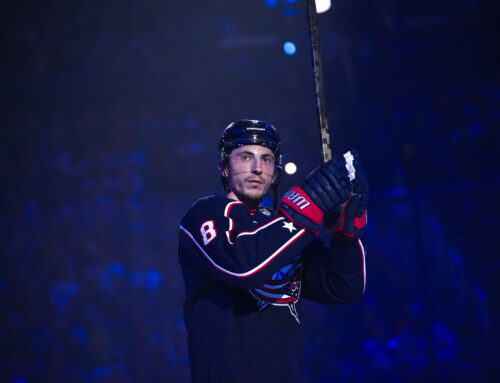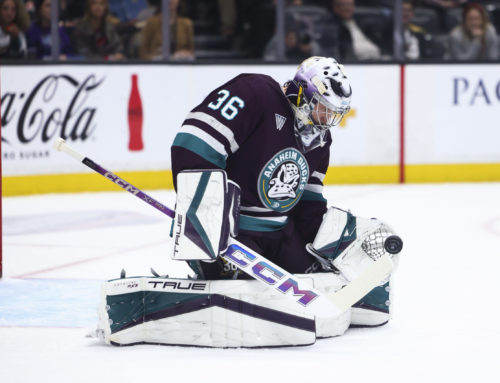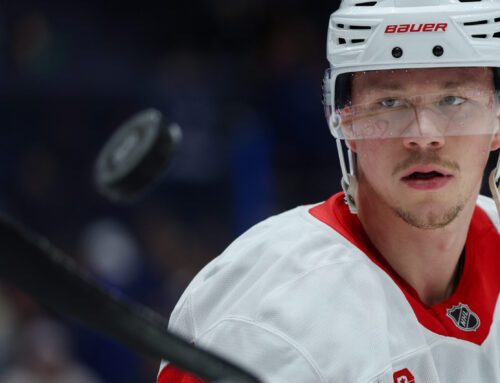September 7, 2014
Thomas Drance
2014-09-07
Thoughts on Babcock and using shot volume and shooting percentage together to find value in fantasy.
***
Pick up the Fantasy Guide here – last update was Thursday!
*
Mike Babcock regrets starting up the whole “is Babcock going to be the most heavily sought after free agent this offseason?” thing with some ham-fisted comments earlier this summer. Here’s the thing: the speculation isn’t necessarily raging because of Babcock’s comments, it’s raging because of his expiring contract.
If the consensus best coach in the NHL wanted to stay in Detroit, I mean really wanted to, wouldn’t he have just signed that extension already? What’s the possible hold up?
Babcock could’ve said nothing on this, except “I love the Red Wings and want to stay here for my entire career” and even that wouldn’t be enough to quell speculation. The only that will is his dry signature on a shiny new contract.
*
Hey it’s tryout season so get your hot Raphael Diaz news here (Detroit is interested)! And your fresh take on Ryan Malone’s chances of cracking the Pittsburgh Penguins Roster here! How about a bit on Todd Bertuzzi wanting to continue his NHL career, fresh off the (word)presses?!
*
Diaz would legitimately help a team like the Red Wings or the Dallas Stars. He’s actually a pretty capable possession defender, who can definitely do Alec Martinez-type things in a bottom pairing role with the right (more defensive minded) partner.
Rob Vollman is one of my favorite hockey writers and is just a tremendous addition to this site. Welcome aboard Rob!
*
I just want to quickly talk about “fancy stats” and the easiest way to use them to make smart bets in fantasy hockey. As any proponent of hockey’s analytics will tell you, many of the stats that are most frequently used (Corsi, Fenwick, PDO etc.) are really, really simple: it’s just addition, subtraction and an understanding of a few simple concepts.
One of those concepts is that shot volume is more important than shot quality, which certainly exists but isn’t important enough to significantly dilute the quality of conclusions one can reach by using shot-based analysis exclusively.
The most compelling argument against shot quality for me was always the fact that, over a large enough sample, something like nine out of 10 NHL players will post an on-ice shooting percentage (so that’s the shooting percentage on all shots taken at five-on-five with a certain player on the ice, not just that player’s individual shooting percentage) between 7 percent and 8.5 percent.
Over a large sample the outliers are the guys you’d expect – Sidney Crosby and Steven Stamkos on the high-end; Scott Gomez and Daniel Winnik on the low-end – which always pleased me intellectually. Over a small sample, you can expect the outliers to regress towards that 7-8.5 percent mean (though obviously Gomez will regress less than a struggling Stamkos).
If you’re still following along, let’s recap what we’ve discussed and try to practically apply it to fantasy hockey. Shot volume is more important than shot quality, shooting percentages are relatively stable over the long-term, and the vast majority of NHL players will ‘regress’ if they post an on-ice shooting percentage much lower (or much higher) than that 7 percent to 8.5 percent window.
*
Now that we know that, we can pick out players who produced shots at a high-rate last season, but were snakebit due to unsustainably low percentages. Generally speaking these players are likely to be undervalued in you fantasy draft but could provide excellent value if they ‘regress’.
Here’s my top-three forwards, all of whom played at least 750 minutes last season, produced shots on goal at a top-60 rate (at five-on-five), and carried an even-strength on-ice shooting percentage below 7 percent (these stats can be found at stats.hockeyanalysis.com by the way). There is value to be had here:
1. Dustin Brown
The 29-year-old Kings captain spent the 2013 offseason recovering from injury and never seemed to get on track during a woeful regular season in 2013-14. A consistent 50-point scorer, Brown managed just 15 goals and 27 points (two fewer than he recorded during the lockout abbreviated 2013 campaign) in the regular season.
Though Brown’s advancing age and diminishing power-play time are significant red flags, he remains a multi-cat beast and a very likely bounce back candidate this upcoming season. In terms of his shot rate, Brown generated looks at a rate better than Patrick Kane and comparable to James van Riemsdyk last season, and only struggled to score because the Kins – as a team – converted just 6.42 percent of shots with Brown on the ice.
The Kings generally do convert a lower percentage of their even-strength shots for whatever reason, but for his career have scored on over 7.5 percent of shots with Brown on the ice. He’s likely to regress points wise this upcoming season and is a good bet to manage roughly 20 goals and 45 points while continuing to rack up a lot of shots, hits and penalty minutes.
2. Cam Atkinson
Some folks will see Atkinson’s 20 goal, 40 point season and call it a breakout. It was, I suppose, but there’s more to the diminutive Blue Jackets sniper than he’s flashed so far.
Atkinson is a legitimate elite shot on goal generator, and managed to put the puck on net at five-on-five at a higher rate than Phil Kessel last season. Despite Atkinson’s volume shooting, his on-ice shooting percentage on the year was well below 7 percent and even more offense can be expected from him next season.
Atkinson doesn’t give you hits, or penalty minutes, which negates his value somewhat depending on the depth and structure of your league. What he will do, and may do even better next season, is take a high volume of shots, score goals and contribute power-play points. Atkinson played on the Blue Jackets’ first unit last season, and I’d expect more of the same this year.
3. Nathan Gerbe
I called Cam Atkinson diminutive, so what does that make Nathan Gerbe?
The NHL’s smallest player managed 31 points a year ago, but should’ve had way more goals (and will this upcoming season).
The former Buffalo Sabres buyout managed the 15th highest even-strength shot rate in the NHL in 2013-14, but finished the year with a brutal 4.9 percent on-ice even-strength conversion rate. That’s some seriously bursty nonsense and just won’t continue next season.
While Gerbe’s a candidate to get 40 points and will absolutely be available late in your draft, he doesn’t contribute much in terms of the peripheral stats. Incoming Hurricanes coach Bill Peters also has a lot of mouths to feed, and I wouldn’t be shocked were Gerbe not a huge factor on the Hurricanes power-play next season.
*
Next weekend we’ll have actual hockey to discuss. Sure, it’ll be prospect tournament hockey – but still – get excited.
Thomas Drance is a news editor at theScore.





 FLA
FLA EDM
EDM MTL
MTL VGK
VGK ANA
ANA DET
DET BUF
BUF N.J
N.J SEA
SEA COL
COL NYI
NYI
